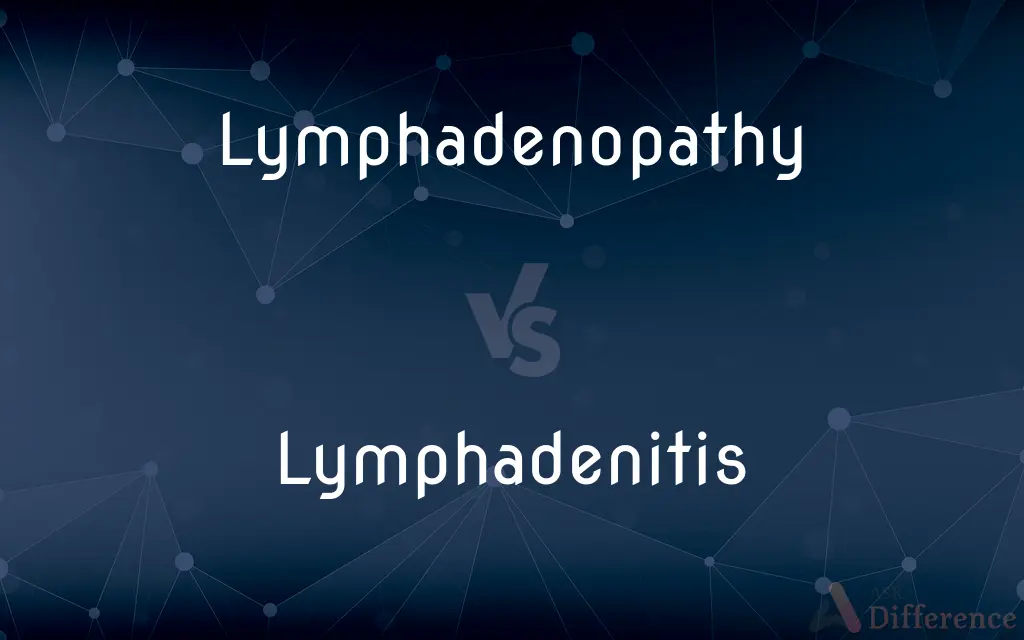Lymphadenopathy vs. Lymphadenitis — What's the Difference?
By Tayyaba Rehman & Fiza Rafique — Published on February 1, 2024
Lymphadenopathy is the abnormal enlargement of lymph nodes, while lymphadenitis specifically refers to the inflammation of lymph nodes.

Difference Between Lymphadenopathy and Lymphadenitis
Table of Contents
ADVERTISEMENT
Key Differences
Lymphadenopathy and lymphadenitis are terms often used in the medical field to describe conditions affecting the lymph nodes. Lymphadenopathy encompasses any enlargement of the lymph nodes, which can be due to various causes including infections, autoimmune diseases, or malignancies. On the other hand, lymphadenitis specifically refers to the inflammation of the lymph nodes, usually caused by an infectious process, indicating an active immune response to a pathogen.
The symptoms of lymphadenopathy can vary widely depending on the underlying cause. It might present as a painless, slow-growing enlargement of nodes in chronic conditions, or as rapid, painful swelling in acute cases. In contrast, lymphadenitis typically presents with localized pain, redness, and warmth, along with the enlarged nodes, signifying inflammation. It's often accompanied by symptoms of the underlying infection, such as fever and malaise.
Diagnosis of lymphadenopathy and lymphadenitis involves a combination of physical examination and medical history. In cases of lymphadenopathy, healthcare providers might look for systemic signs to identify potential causes, like infections, autoimmune disorders, or cancers. With lymphadenitis, the focus is often on identifying the infectious agent, through blood tests, cultures, or imaging studies, to guide appropriate treatment.
Treatment approaches for lymphadenopathy and lymphadenitis differ based on their causes. Lymphadenopathy may require a broad range of treatments from watchful waiting in benign cases to chemotherapy or radiation for cancers. Lymphadenitis, being often infection-related, usually responds to antibiotics or antiviral medications, alongside supportive care to alleviate symptoms.
Prevention and prognosis of lymphadenopathy and lymphadenitis also vary. Lymphadenopathy’s prevention depends on the underlying cause, such as vaccinations for preventable infections or lifestyle changes for certain cancers. Lymphadenitis prevention focuses on general infection control measures. Prognosis for lymphadenopathy is highly variable, while lymphadenitis generally has a good prognosis with timely and appropriate treatment.
ADVERTISEMENT
Comparison Chart
Definition
Abnormal enlargement of lymph nodes
Inflammation of lymph nodes
Causes
Infections, autoimmune diseases, malignancies
Usually infectious agents
Symptoms
May be painless or painful, slow or rapid swelling
Painful, red, warm nodes, often with fever
Diagnosis
Based on systemic signs, possibly imaging or biopsy
Focus on identifying infectious agent, blood tests
Treatment
Varied: watchful waiting, medication, or cancer treatment
Antibiotics or antiviral medications, supportive care
Compare with Definitions
Lymphadenopathy
Abnormal enlargement of lymph nodes.
The patient's lymphadenopathy was noticeable in the neck region.
Lymphadenitis
Often results from an infection near the affected lymph node.
Dental infection led to lymphadenitis in his jaw.
Lymphadenopathy
A clinical sign, not a diagnosis, indicating potential underlying health issues.
Lymphadenopathy in her armpits led to further medical investigation.
Lymphadenitis
Typically presents with pain and tenderness in the affected area.
The child complained of painful lymphadenitis under his arm.
Lymphadenopathy
Can occur in a single node or multiple nodes.
His lymphadenopathy was localized to the groin area.
Lymphadenitis
Usually treated effectively with appropriate antibiotics.
His lymphadenitis improved with antibiotic therapy.
Lymphadenopathy
Often detected during physical examinations.
The general practitioner felt lymphadenopathy during the routine check-up.
Lymphadenitis
May be accompanied by systemic symptoms like fever.
She had lymphadenitis with a high fever, indicating an infection.
Lymphadenopathy
May be benign or indicative of serious conditions.
The doctor explained that lymphadenopathy could range from simple infections to cancer.
Lymphadenitis
Inflammation of one or more lymph nodes.
Lymphadenopathy
An enlargement of the lymph nodes, usually associated with disease.
Lymphadenitis
Inflammation or swelling of lymph nodes; it is often a nonspecific sign of infection but is also often of obscure origin and benign.
Lymphadenopathy
(medicine) An abnormal enlargement of the lymph nodes; it is often a nonspecific sign of infection but is also often of obscure origin and benign.
Lymphadenitis
Inflammation of the lymphatic glands; - called also lymphitis.
Lymphadenopathy
Chronic abnormal enlargement of the lymph nodes (usually associated with disease)
Lymphadenitis
Inflammation of lymph nodes
Common Curiosities
What causes lymphadenopathy?
Lymphadenopathy can be caused by infections, autoimmune diseases, or cancers.
Is lymphadenitis always painful?
Typically, lymphadenitis presents with pain and tenderness in the affected lymph node.
How long does lymphadenopathy last?
The duration varies based on the underlying cause, ranging from days to months.
How is lymphadenitis diagnosed?
Lymphadenitis is diagnosed based on symptoms, physical examination, and sometimes blood tests or cultures.
What are the treatment options for lymphadenitis?
Treatment typically includes antibiotics or antivirals, depending on the infection.
Is surgery ever needed for lymphadenitis?
Surgery is rare but might be needed in cases of abscess formation.
Can lymphadenopathy occur without an underlying disease?
Yes, it can sometimes be a benign condition without serious underlying causes.
Are swollen lymph nodes always a sign of lymphadenopathy?
Yes, swollen lymph nodes are characteristic of lymphadenopathy.
Can children experience lymphadenopathy?
Yes, children can experience lymphadenopathy, often due to infections.
Can allergies cause lymphadenopathy?
Allergies are a less common cause, but they can lead to lymphadenopathy in some cases.
Is lymphadenitis contagious?
The condition itself is not contagious, but the underlying infection might be.
Can vaccines prevent lymphadenopathy?
Vaccines can prevent certain infections that cause lymphadenopathy.
Can lymphadenitis lead to complications?
If untreated, lymphadenitis can lead to complications like abscess formation.
Is lymphadenitis a sign of cancer?
While lymphadenitis itself is usually due to infection, persistent or unexplained lymph node inflammation should be evaluated for other causes, including cancer.
Are there lifestyle factors that can reduce lymphadenopathy risk?
Maintaining overall health, like good hygiene and a balanced diet, can reduce the risk.
Share Your Discovery

Previous Comparison
Phonics vs. Phonemes
Next Comparison
Balcony vs. RoofAuthor Spotlight
Written by
Tayyaba RehmanTayyaba Rehman is a distinguished writer, currently serving as a primary contributor to askdifference.com. As a researcher in semantics and etymology, Tayyaba's passion for the complexity of languages and their distinctions has found a perfect home on the platform. Tayyaba delves into the intricacies of language, distinguishing between commonly confused words and phrases, thereby providing clarity for readers worldwide.
Co-written by
Fiza RafiqueFiza Rafique is a skilled content writer at AskDifference.com, where she meticulously refines and enhances written pieces. Drawing from her vast editorial expertise, Fiza ensures clarity, accuracy, and precision in every article. Passionate about language, she continually seeks to elevate the quality of content for readers worldwide.
















































